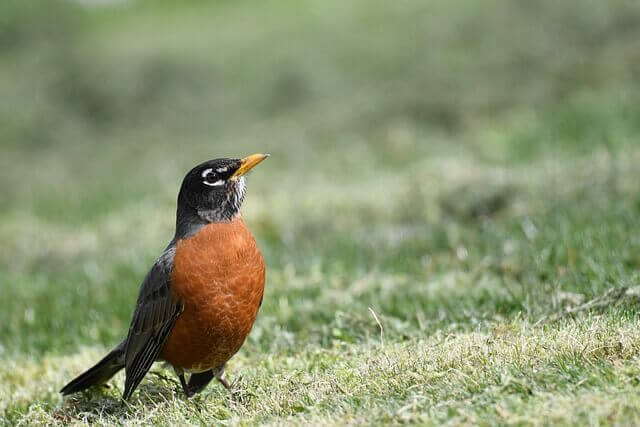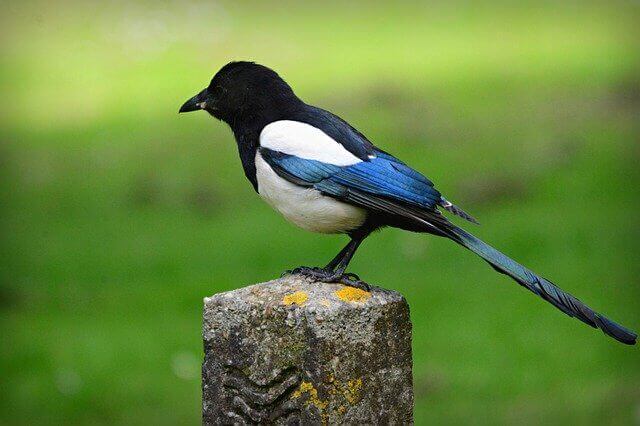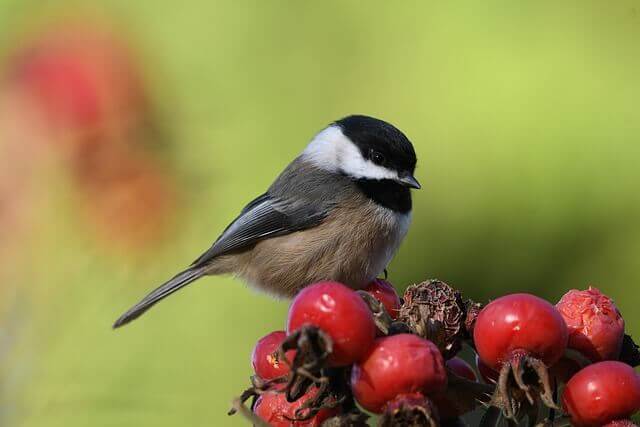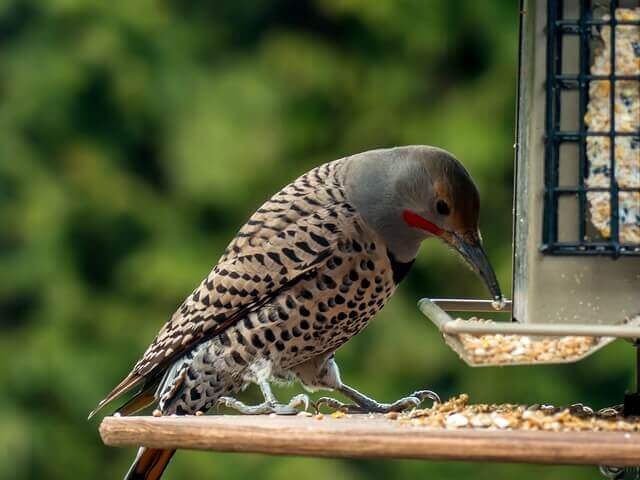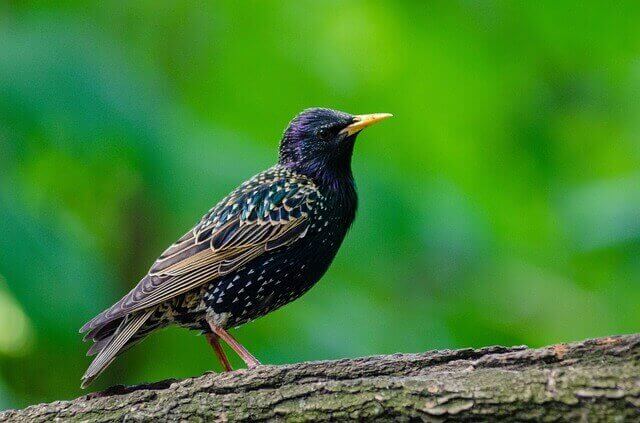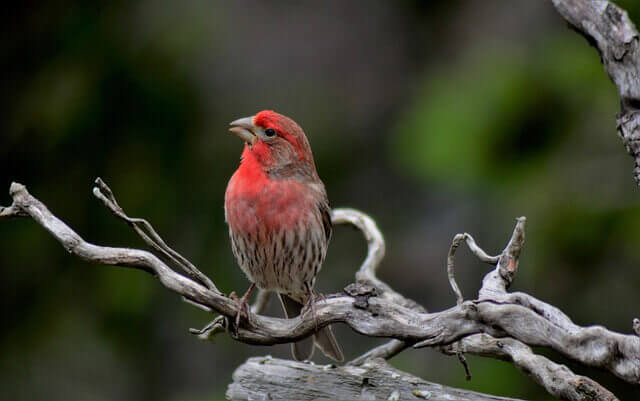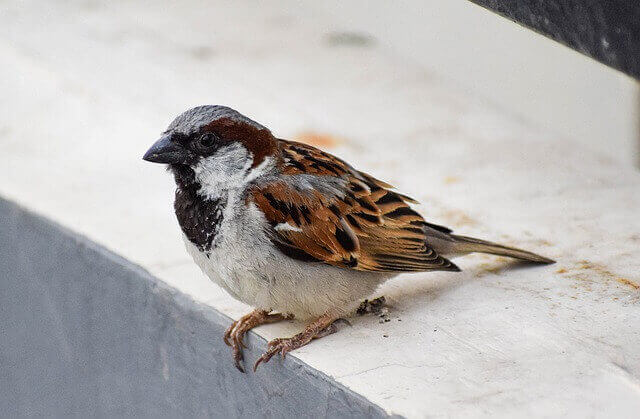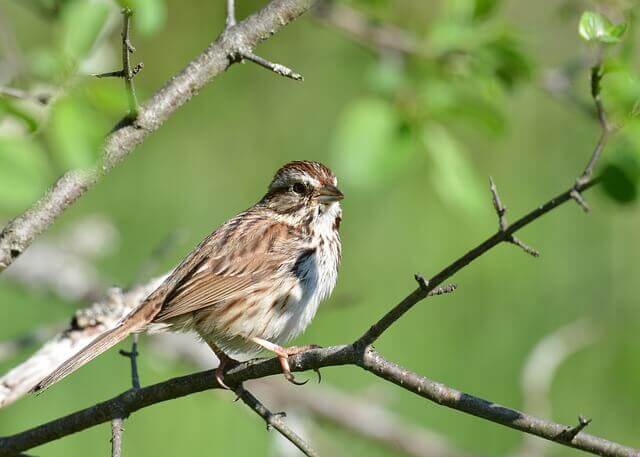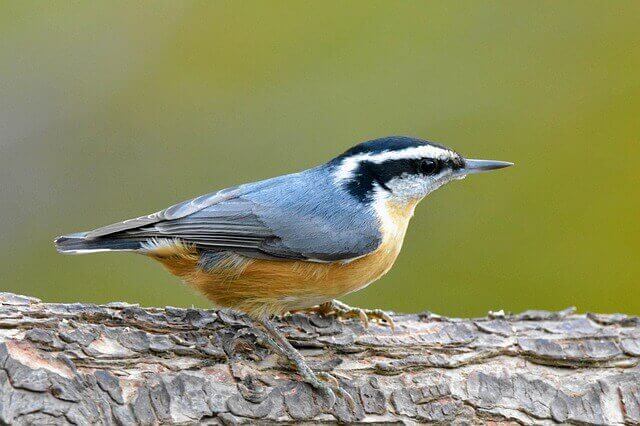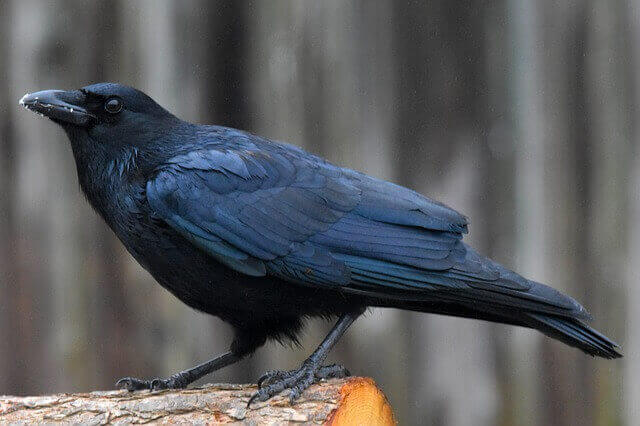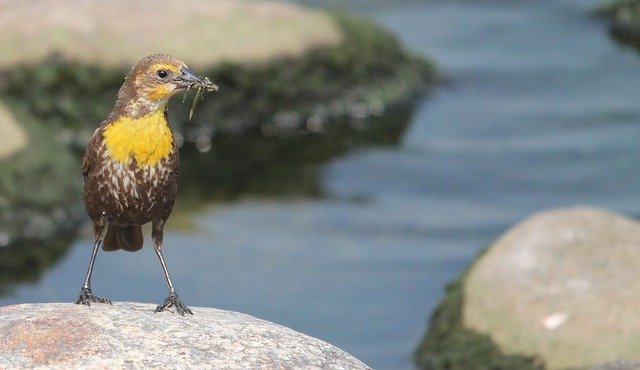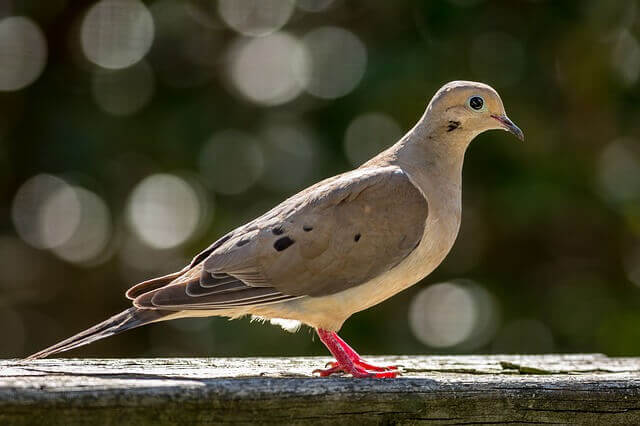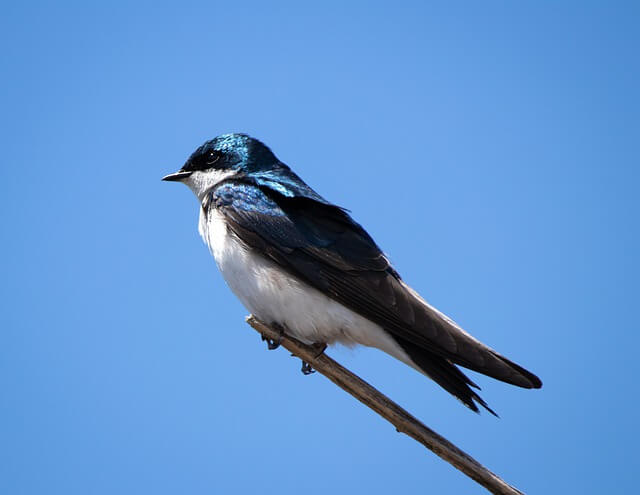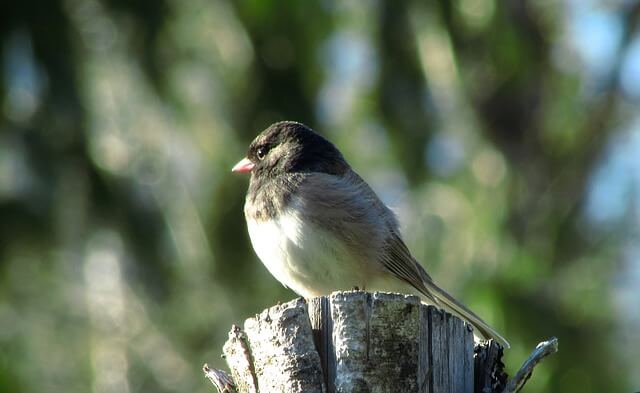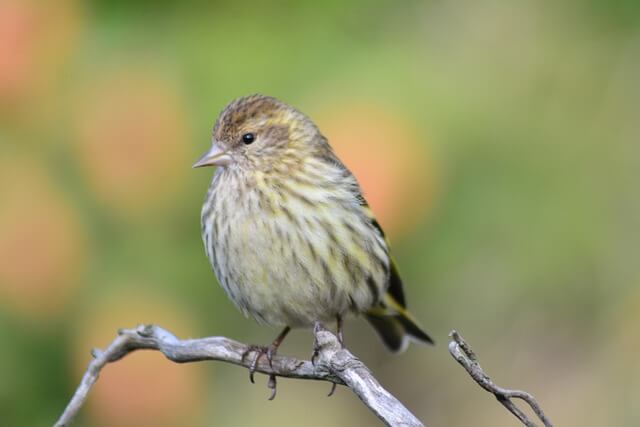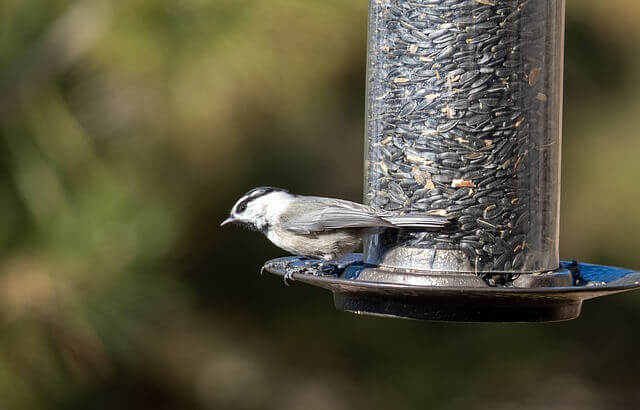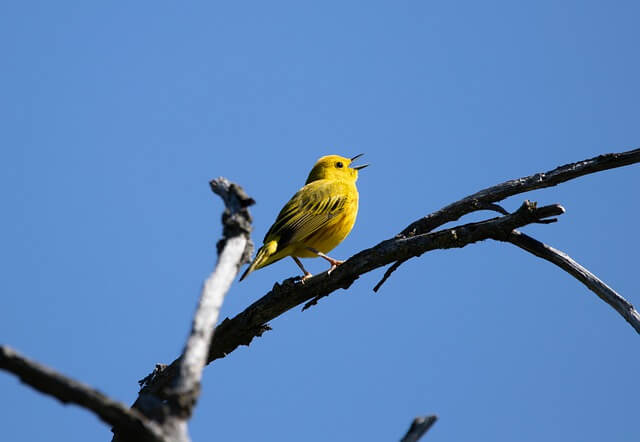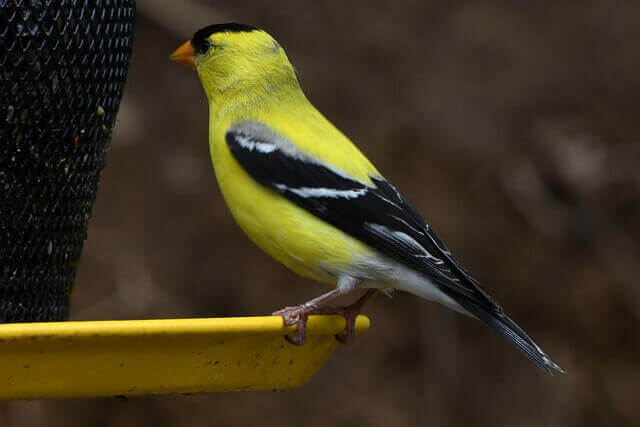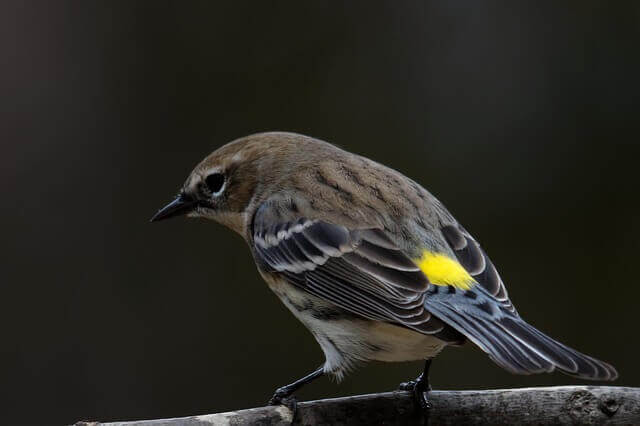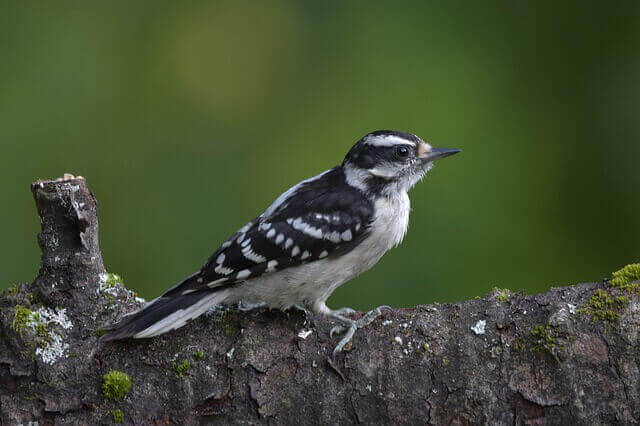Embark on an enthralling journey through Montana’s diverse birding landscape with our comprehensive guide. This Ultimate Guide highlights the 40 most common birds found throughout the Treasure State, offering detailed insights into their habitats, behaviors, and distinctive characteristics.
Whether you’re a dedicated birder, an outdoor enthusiast, or simply curious about Montana’s unique birdlife, this guide provides a captivating exploration of the avian wonders that grace this majestic state.
Table of Contents
- 1 Common Backyard Birds in Montana
- 1.1 American Robin
- 1.2 Black-billed Magpie
- 1.3 Black-capped Chickadee
- 1.4 Northern Flicker
- 1.5 Common Starling
- 1.6 House Finch
- 1.7 House Sparrow
- 1.8 Eurasian-collared Dove
- 1.9 Song Sparrow
- 1.10 Red-breasted Nuthatch
- 1.11 American Crow
- 1.12 Western Meadowlark
- 1.13 Mourning Dove
- 1.14 Tree Swallow
- 1.15 Dark-eyed Junco
- 1.16 Pine Siskin
- 1.17 Mountain Chickadee
- 1.18 Yellow Warbler
- 1.19 American Goldfinch
- 1.20 Yellow-rumped Warbler
- 1.21 Downy Woodpecker
- 2 Frequently Asked Questions
- 2.1 What is the most common bird in Montana?
- 2.2 What is the black and white bird in Montana?
- 2.3 Are there sandhill cranes in Montana?
- 2.4 Do ravens live in Montana?
- 2.5 How many birds are in Montana?
- 2.6 Are there catbirds in Montana?
- 2.7 Are there buzzards in Montana?
- 2.8 What is the largest bird in Montana?
- 2.9 What bird is Montana known for?
- 2.10 Are there puffins in Montana?
- 2.11 Are there Raptors in Montana?
- 2.12 Are there golden eagles in Montana?
- 2.13 Are there falcons in Montana?
- 2.14 Are there eagles in Montana?
- 3 Author
Common Backyard Birds in Montana
American Robin
The American Robin is one of the best songbirds to see in Montana. The Robin can be seen all year round, but the best time to visit the state of Montana to see the American Robin is from late May to early June.
The peak time for seeing them is June and July. It is in this period of the year that they are at their most aggressive, so it is best to see them early morning.
- Frequency: 39.39%
- Color: Brown on the back with an orange breast
- Habitat: Wooded areas, backyards, parks, fields
- Range: USA, Canada, Mexico
- Size: 12 – 16″ inches
- Weight: 72 – 95 grams
- Diet: Fruits, berries and insects (earthworms, beetles, caterpillars)
- Family: Turdidae
- Genus: Turdus
Related Post:
Black-billed Magpie
The Black-billed Magpie is a beautiful bird that can be found in the southern part of the United States. One of the best places in Montana to find a Black-billed Magpie is on the forested ridges along the river front.
They are more abundant during the winter season, which occurs mostly between December and January. During the spring, however, there is less abundance.
- Frequency: 37.20%
- Color: Black & white with blue areas on the wing and tail.
- Habitat: Roadsides, backyards, country, towns, parks and fields
- Range: Western half of North America
- Size: 18 -24″ inches
- Weight: 165 – 215 grams
- Diet: Insects, carrion, nuts, seeds, berries, rodents and eggs
- Family: Corvidae
- Genus: Pica
Related Post: 8 Birds That Build Mud Nests
Black-capped Chickadee
One of the most common species, the Black-Capped Chickadee, is very easily found here. It is mostly found in the southern and northern regions. You will probably have the best luck searching for these birds during the summer months, especially from June to September.
There are several places you can find these birds in Montana. The main ones are the Great Falls, the Yellowstone, and the Continental Divide.
- Frequency: 31.93%
- Color: Black cap, white on face, white/reddish-brown flanks
- Habitat: Deciduous and mixed forests, backyards, parks
- Range: USA and Canada
- Size: 11.5 -16 cm
- Weight: 8 – 15 grams
- Diet: Insects, seeds, berries
- Family: Paridae
- Genus: Poecile
Related Post:
Northern Flicker
The Northern Flicker is a type of woodpecker found in North America. They are fairly common birds, and range from Canada to Mexico, except for the Rocky Mountains. Their habitat includes fields, forests and backyards with trees. The Northern Flicker eats insects such as ants or beetles that they find on the ground.
Northern Flickers usually migrate during October and November because they need to escape the cold winter months when food becomes scarce due to lack of insect activity or food sources. These birds can be seen in both urban and rural areas of Montana.
- Frequency: 29.81%
- Color: Light brown with black bars across back, chest, wings, belly
- Habitat: Forests, woodlands, backyards, edges, yards, and parks
- Range: North America, Central America, Cuba, Cayman Islands
- Size: 10 – 14″ inches
- Weight: 85 – 165 grams
- Diet: Insects (ants, beetles, invertebrates), fruits, seeds, berries
- Family: Picadae
- Genus: Colaptes
Related Post: How to Attract Northern Flickers to your Backyard
Common Starling
The Common Starlings (European Starling) are a species of bird that live in the Americas, Europe and Asia. They range from southern Canada to Argentina in South America. The habitat for these birds includes temperate climates to tropical environments, as well as wetlands, forests and gardens.
These birds typically eat insects but also feed on small vertebrates such as frogs, snakes or rodents; fruit including berries and figs; seeds; plants such as ferns, grasses or mosses; invertebrates like earthworms. In terms of migration pattern, they tend to fly south for the winter, but some may stay all year round in warmer climates.
- Frequency: 26.24%
- Color: Black with glossy iridescence plumage
- Habitat: Forests, woodlands, backyards, edges, yards, and parks
- Range: North America, Europe, Africa, India, Middle East, China
- Size: 7 – 9″ inches
- Weight: 60 – 100 grams
- Diet: Insects (ants, beetles, invertebrates), fruits, seeds, berries
- Family: Picadae
- Genus: Colaptes
Related Post: How to Attract European Starlings to your yard?
House Finch
House Finch is a popular species in many parts of the state. It occurs in a wide variety of habitats including woodlands, rocky areas, deserts, grasslands, and even urban neighborhoods. The House Finch is commonly found in the interior of the state.
Many people enjoy the company of house finches in their backyard. If you are looking for a way to attract these birds, here are some tips: -Use sunflower seeds as bird feeders and in the ground -Provide lots of water (finches love fresh water). If they have access to water on a regular basis, then this species will make great residents in your backyards.
- Frequency: 21.40%
- Color: Reddish face and upper breast,brown streaks on back, belly and tail.
- Habitat: urban and suburban areas, backyards, edges, yards, and parks
- Range: Canada, USA, Mexico
- Size: 5 – 6″ inches
- Weight: 16 – 27 grams
- Diet: Aphids, grains, seeds, berries, nettle, dandelion, sunflower
- Family: Fringillidae
- Genus: Haemorhous
Related Post: How to Attract House Finch to your Yard
House Sparrow
House sparrows are found in almost every city and town across the United States. They nest on rooftops, bushes, and other places that provide cover from predators. They are common all over the state and can be seen everywhere from backyards to public parks.
If you want to see house sparrows for yourself, check out these places below: – The Swan River National Wildlife Refuge – This park is located off of Highway 2 East, about 30 miles south of Kalispell. It’s home to an abundance of wildlife and offers hiking trails as well as campsites for visitors.
- Frequency: 19.60%
- Color: Gray head marking, a reddish-brown back, and gray underparts
- Habitat: Urban centres, suburban areas, backyards, edges, yards, and parks
- Range: North America, Central America, South America, Africa, Australia, New Zealand
- Size: 5.5 – 7.1″ inches
- Weight: 25 – 39 grams
- Diet: Insects, beetles, caterpillars, aphids,, grasshoppers, crustaceans, earthworms, vertebrates
- Family: Passeridea
- Genus: Passer
Related Post: How to Attract Sparrows to your Backyard
Eurasian-collared Dove
The Eurasian Collared Dove is the most widely distributed bird on the planet. It is a member of the Columbidae family, which includes pigeons and doves. It lives throughout Europe and Asia, but can be found here in North America. They can also be found in all sorts of habitats but prefers areas with little vegetation or tall trees like deserts, open fields, parks and gardens.
Eurasian Collared Doves eat seeds, fruit and insects they find on the ground below them. In Montana, it is found at numerous sites, including a number of large bodies of water, along the western slopes of the Continental Divide, on the Great Plains, along the Rocky Mountains, and in the northern Rocky Mountains.
- Frequency: 17.16%
- Color: Pinkish-gray with ablack half-collar bar with white on its neck
- Habitat: Urban centres, farms, backyards, edges, yards, and parks
- Range: North America, Central America, South America, Europe, Asia
- Size: 13″ inches
- Weight: 150 grams
- Diet: Millet, milo, sunflower, wheat, corn and berries
- Family: Columbidae
- Genus: Streptopelia
Song Sparrow
Song Sparrows are a common bird in North America. They are migratory birds that migrate south for the winter and back north during the spring and summer. These sparrows live mainly in open fields, parks, pastures, prairies and scrublands.
They eat mostly insects such as beetles, ants and grasshoppers but also feed on seeds from plants such as dandelions, ragweed or thistles. The song sparrow is native to eastern Canada through Mexico, with some subspecies migrate south in the winter while others stay year-round.
- Frequency: 16.34%
- Color: Gray head, white cheek, a black bib, rufous neck
- Habitat: Urban centres, farms, backyards, edges, yards, and parks
- Range: Europe, Mediterranean, Asia, Australasia, Africa, and the Americas
- Size: 5.5 – 7.0″ inches
- Weight: 25 – 40 grams
- Diet: Grains, seeds and insects
- Family: Passeridea
- Genus: Passer
Related Post: How to Attract Sparrows to your Backyard
Red-breasted Nuthatch
The Red-breasted Nuthatch is a common bird in Montana. Their range is limited to the Rocky Mountains and parts of Wyoming and Idaho.
If you live in or around the Great Yellowstone area, you may want to consider looking for the Red-breasted Nuthatch. This bird often nests in tree hollows. Sometimes you will find them feeding on a fallen tree trunk. They will feed on both insects and small birds during the day and then fly into a tree at night.
- Frequency: 16.24%
- Color: Blue-gray on top with a cinnamon under, white face & throat, with a black stripe on the eye
- Habitat: Coniferous forests, woodlands
- Range: North America, Asia
- Size: 4.5″ inches
- Weight: 10 grams
- Diet: Grains, seeds ,nuts, spiders and insects
- Family: Sittidae
- Genus: Sitta
Related Post: How to Attract Nuthatches to your Backyard
American Crow
American Crows are the most widespread and abundant of all North American crows. They have a range that covers nearly the entire continent, from southern Canada to Central America. Their habitat includes suburban parks, rural farmland, deserts and rainforests. Their diet is omnivorous, but they prefer large insects such as grasshoppers, beetles and crickets; eggs; small mammals like mice or rabbits; carrion (dead animals); scraps in urban areas and some fruit.
This species migrates during the winter months, when it travels south to Mexico or Central America before returning north in spring. These birds can be found throughout the state as well, and you can often spot them on the ground, flying up into the trees, or sitting quietly.
- Frequency: 16.02%
- Color: Black
- Habitat: Open country, farms, parks, woodlands, towns, cities
- Range: Canada, USA, Mexico
- Size: 16 – 21″ inches
- Weight: 315 -620 grams
- Diet: invertebrates, carrion, seeds, eggs fish, grains, mice, frogs, and other small animals.
- Family: Corvidae
- Genus: Corvis
Related Posts:
Western Meadowlark
Western Meadowlarks are small, medium-sized birds that live in open country and often feed on the ground. The Western Meadowlark is found across most of North America east of the Rocky Mountains. It breeds from Alaska to Labrador, south to Mexico and Arizona, as well as along the Gulf Coast and Atlantic coast down to Florida.
The habitat for this bird includes any open area with low vegetation, such as grasslands or agricultural fields. They are not a migratory species, but may move to warmer areas for food sources, breeding and wintering.
- Frequency: 15.64%
- Color: Mostly brown upper with black streaks and yellow underparts
- Habitat: Pastures, prairies, grasslands, and fields,
- Range: Western and central North America
- Size: 8.5″ inches
- Weight: 90 – 115 grams
- Diet: Bugs, seeds, berries
- Family: Icteridae
- Genus: Sturnella
Mourning Dove
Mourning doves are one of the most common birds in North America. They live across Canada and the United States, from as far north as Alaska to Mexico. Mourning doves live in a variety of habitats, including fields, forests, mountains and even beaches.
Mourning doves eat seeds and grains as well as insects like grasshoppers, crickets and caterpillars. Their range is vast because they migrate south for winter and then back north when spring arrives
- Frequency: 15.39%
- Color: Light gray-brown and lighter and pinkish below. The wings have black spots.
- Habitat: Open habitats, urban areas, farms, prairie, grassland, wooded area
- Range: USA, Canada, Mexico, Central America, Greater Antilles
- Size: 12″ inches
- Weight: 112 – 170 grams
- Diet: Rapeseed, corn, millet, safflower, sunflower seeds, pokeberry, sesame, and wheat.
- Family: Columbidae
- Genus: Zenaida
Related Posts: 10 Facts about Mourning Doves
Tree Swallow
Tree Swallows are one of the most common and recognizable swallows in North America. They have a range from central Alaska to Newfoundland, across southern Canada and the eastern United States. Tree Swallows can be found living near water or wetlands like ponds, lakes, rivers, marshes or creeks.
In addition to their habitat they also eat flies, dragonflies and beetles as well as some small fish that they catch while on migration south for winter. Swallows migrate up to 5500 miles each year for their breeding season during March through July when they spend time nesting in trees or cavities of buildings such as barns.
- Frequency: 15.20%
- Color: Bluish-green upper with black wings and tail, and white underbody
- Habitat: Open wooded areas
- Range: USA, Canada, South America
- Size: 4.5 – 5.5″ inches
- Weight: 17 – 26 grams
- Diet: insects, molluscs, spiders, and fruit
- Family: Hirundinidae
- Genus: Tachycineta
Related Post: How to Attract Swallows to my Yard
Dark-eyed Junco
The Dark-Eyed Junco, a bird of the junco family, is one of North America’s most widespread and abundant songbirds. They are found in forests, orchards, fields and other habitats from southern Canada to northern Mexico. It has an extensive range in North America and breeds from Alaska to New England, and as far south as California, Arizona, Colorado and Texas.
The juncos feed on insects that they find by pecking through snow cover for dead bugs. In winter, when food is scarce, they may fly into open country looking for seeds or berries before returning to their forest home.
- Frequency: 15.01%
- Color: Gray head, neck, breast, gray/brown backs and wings, white underside
- Habitat: Wooded areas, forest edges, roadsides, gardens, parks.
- Range: USA and Canada
- Size: 5.1 – 6.9″ inches
- Weight: 18 – 30 grams
- Diet: Seeds, insects and arthropods
- Family: Passeriformes
- Genus: Junco
Related Post: Interesting Dark-eyed Junco Fun Facts
Pine Siskin
The Pine Siskin is actually a North American bird, belonging to the Spinus family. It’s a very migratory bird, with an irregular winter range and no permanent residence in the United States.
Its migration takes it from the waters of the North Pacific to the Atlantic and South Atlantic. It has a large flight range in which it can fly thousand miles from where it is born.
It prefers to feed on a variety of woody plants, including but not limited to ash, cedar, juniper, hemlock, oak, hickory, and white pine. It nests on the ground during the night and makes for a great winter migratory bird.
- Frequency: 14.41%
- Color: Brown upper and pale under, yellow or white patches on wings
- Habitat: Deciduous forests and thickets, roadside, grasslands, backyards, meadows
- Range: USA, Canada
- Size: 4.5 – 5.5″ inches
- Weight: 12 -18 grams
- Diet: Grass, dandelions, chickweed, sunflowers and ragweed, thistle, red alder, birch, spruce seeds
- Family: Spinus
- Genus: S. pinus
Mountain Chickadee
Mountain Chickadee is quite plentiful in the mountains of Montana and are a great choice for your wildlife watching activity. They are excellent climbers and enjoy hanging on trees, so if you are going on a bird watching trip near the woods then these birds will be the ones that get your attention.
If you are going to a national park or a wildlife refuge then the Montana population of Mountain Chickadee will be larger. In addition to their popularity in Montana, Mountain Chickadee has made their way into all parts of North America.
Their habitat is mostly wooded hillsides where they can hide in the brush droppings. They are very good swimmers and if you are looking for a great place to enjoy an afternoon picnic, you can find a lot of them along river banks and creeks.
- Frequency: 13.27%
- Color: Black cap, gray flank and back, lighter gray underparts
- Habitat: Mountains, forests, juniper stands and rivers
- Range: Western USA and Canada
- Size: 5 -6” inches
- Weight: 11 grams
- Diet: Mostly insects, seeds, and berries.
- Family: Paridae
- Genus: Poecile
Related Post: How Do I Attract Chickadees To My Yard
Yellow Warbler
The Yellow Warblers are a rare and very small bird. The range of the Yellow Warbler is North America, Europe, Africa and Asia. Their habitat is in many types of environments like rainforests, deserts or even tundra-like regions. They migrate between their winter homes to summer homes depending on the season. The diet of this bird consists mainly of insects that they hunt for themselves by hopping around the ground looking for food such as beetles or ants.
The wintering grounds for these species include coastal regions from South Carolina to Florida. The yellow warbler can be found throughout Montana and is a very beautiful bird. Many individuals who live in Montana have discovered this bird in their backyards.
- Frequency: 13.10%
- Color: Greenish-yellow upper and are a duller yellow underside
- Habitat: marshes,swamps, streams, thickets, orchards, farmlands, forest edges, backyards
- Range: North America, Central America, South America
- Size: 4.0 – 7.0″ inches
- Weight: 7 – 25 grams
- Diet: caterpillars,mayflies, moths, mosquitoes, beetles, damselflies, treehoppers, spiders, berries.
- Family: Parulidae
- Genus: Setophaga
Related Post: How to Attract Yellow Warblers to your Backyard
American Goldfinch
The American Goldfinches are a beautiful species of bird that live in North America. They can be found anywhere from Alaska to the Atlantic Ocean, with a range that spans across Canada and the United States. Their habitat ranges from grasslands to forests, and their diet consists mostly of seeds, grains, fruits and insects.
These birds also migrate each year between breeding grounds in Canada or the northern United States to wintering grounds in Mexico or Central America.
- Frequency: 12.74%
- Color: Face, neck and underside are yellow, black wings with white bars
- Habitat: Deciduous forests and thickets, roadside, grasslands, backyards, meadows
- Range: Canada, USA and Mexico
- Size: 4.3 – 5.5″ inches
- Weight: 12 -18 grams
- Diet: Grass, dandelions, chickweed, sunflowers and ragweed, thistle, red alder, birch, spruce seeds
- Family: Carduelinae
- Genus: Spinus
Related Post: American Goldfinch Interesting Facts
Yellow-rumped Warbler
The Yellow-rumped Warbler is a migratory bird that lives in eastern North America. The range of the Yellow-rumped Warblers include Eastern United States, Southern Canada and Western United States. They live in deciduous forests with many dead trees because they are looking for nest sites or food sources.
The diet of the warblers includes small insects such as ants, spiders, caterpillars and beetles; fruits such as wild cherries, mulberries and sumac berries. These birds migrate to the United States during winter and return to their summer habitats in Canada, Mexico, Central America and South America.
- Frequency: 12.39%
- Color: Yellow patches on the crown,flanks, rump & blackish-blue streaks on the back, breast and wings
- Habitat: Deciduous forests and thickets, roadside, grasslands, backyards
- Range: U.SA, Canada, Mexico, Central America, and the Caribbean
- Size: 4.7 – 5.9″ inches
- Weight: 10 – 18 grams
- Diet: grasshoppers, gnats, aphids,caterpillars, wasps, beetles, spiders, berries,
- Family: Parulidae
- Genus: Setophaga
Related Post: How to Attract Warblers to you Yard?
Downy Woodpecker
Downy Woodpeckers are a common bird in North America. They live all over the continent and range from Mexico to Canada. Their habitat includes both urban and rural areas, but they prefer mixed forests with plenty of dead trees for them to drill into.
They feed on insects, berries, nuts and seeds, which makes them omnivores as well as insectivores. In their search for food, Downy Woodpeckers also travel back and forth between continents during migration season, with birds heading south in winter time and returning north when it is warmer.
- Frequency: 12.04%
- Color: Mainly black with a white throat, belly and back. Has white spots and the wings
- Habitat: Deciduous forests and thickets, roadside, grasslands, backyards, parks
- Range: Canada, USA and Mexico
- Size: 5.5 – 7.1″ inches
- Weight: 20 – 33 grams
- Diet: Mostly insects and beetles and ants, also gall wasps, caterpillars
- Family: Picadae
- Genus: Dryobates
Related Posts: How to Attract Downy Woodpeckers: Expert Tips!
These backyard birds have a frequency of less than 10%.
- Chipping Sparrow (Frequency 9.88%)
- Brown-headed Cowbird (Frequency 9.80%)
- House Wren (Frequency 8.58%)
- Eastern Kingbird (Frequency 8.22%)
- Ruby-crowned Kinglet (Frequency 8.05%)
- Western-wood Peewee (Frequency 7.26%)
- American Kestrel (Frequency 7.24%)
- Gray Catbird (Frequency 7.18%)
- Vesper Sparrow (Frequency 7.10%)
- Savannah Sparrow (Frequency 7.04%)
- Mountain Bluebird Frequency 7.02%)
- Hairy Woodpecker (Frequency 6.91%)
- Common Grackle (Frequency 6.72%)
- Evening Grosbeak (Frequency 6.14%)
- Warbling Vireo (Frequency 6.02%)
- Yellow-headed Blackbird (Frequency 5.91%)
- Western Tanager (Frequency 5.87%)
- Common Yellow-throat Frequency 5.58%)
Frequently Asked Questions
What is the most common bird in Montana?
The American Robin is the most common bird in Montana with a 40% frequency of occurrence throughout the state. They are generally found in open fields where they eat insects like grasshoppers and crickets as well as seeds from plants such as dandelions and thistles.
What is the black and white bird in Montana?
Black-billed Magpie is a black and white bird found in Montana. They are members of the Corvidae family, which includes crows, ravens, jays, magpies and nutcrackers. They can be found throughout Montana, but is more commonly seen near agricultural areas.
Are there sandhill cranes in Montana?
Yes, there are Sandhill Cranes in Montana. Sandhill cranes have migrated to the state of Montana and stay for most of the year. They live in places like Flathead Lake, the Missouri River Breaks, and Pryor Mountain.
Do ravens live in Montana?
The answer is a definite yes. Ravens are very common throughout the state of Montana, and some have even found their way to living near people. They are usually most commonly seen around water sources such as rivers or lakes, where they will scavenge for food that animals have left behind on the shoreline.
How many birds are in Montana?
Montana is home to 441 species of birds according to eBird. This includes a large variety of common and rare bird species that make their homes in Montana’s diverse habitats. As one might expect, the state has some specific environments with different types of birds associated with them.
Are there catbirds in Montana?
Catbirds are birds that live in the eastern United States. They are not native to Montana, so they do not inhabit the state. There is a 7% frequency of occurrence for gray catbirds in Montana, which would make them fairly rare there.
Are there buzzards in Montana?
Buzzards are turkey vultures that can be found in Montana, but not all the time. The buzzard population is influenced by a number of factors, including food availability and climatic conditions such as rainfall or drought.
What is the largest bird in Montana?
The Ferruginous Hawk is the largest bird in Montana. It can reach a wingspan of up to 5 feet and weigh almost three and a half pounds. The hawk is found throughout much of North America, including parts of Canada, the United States, and Mexico.
What bird is Montana known for?
Montana is known for its Western Meadowlark. The bird was officially adopted by the state of Montana on March 14, 1931. The Western Meadowlark is a small songbird that is found in North America. It is known for its bright yellow and black plumage, and for its strong singing voice.
Are there puffins in Montana?
Puffins, auks, and murres are all species of seabirds that can be found in Montana. All three of these birds live on islands located off of the coast of North America. Puffins are the most common seabird in Montana, and can be found on many different islands near the state’s coastline. Auks are a smaller bird than puffins, and can be found on remote islands as well as some coastal areas. Murres are the smallest of the three seabirds, and can only be found on a few small offshore islands in Montana.
Are there Raptors in Montana?
Montana has something for everyone. One raptor that can be found throughout the state is the red-tailed hawk. The bald eagle is a majestic bird that can be found all throughout Montana, but is especially abundant in Yellowstone National Park. The northern goshawk is another species that can be found throughout most of Montana, but is particularly common in mountainous areas.
Are there golden eagles in Montana?
Montana is home to a significant number of golden eagles! In fact, Montana ranks as one of the most eagle-populated states in the United States. Golden eagles are found all over North America, but these magnificent birds can be particularly abundant in areas with large game populations.
Are there falcons in Montana?
Falcons are widespread throughout the United States, but there are only five species of true falcons in Montana. The American Kestrel, Gyrfalcon, Peregrine Falcon, Prairie Falcon and Merlin can be found in Montana. However, populations of these birds vary greatly in numbers, so it is important to know the difference between each before attempting to identify them.
Are there eagles in Montana?
Montana is home to two species of eagles – the bald eagle and the golden eagle. Bald eagles are the most common type of eagle in Montana, while golden eagles are relatively uncommon. Both species of eagles are protected under state and federal law, so it is illegal to harass or kill them.


